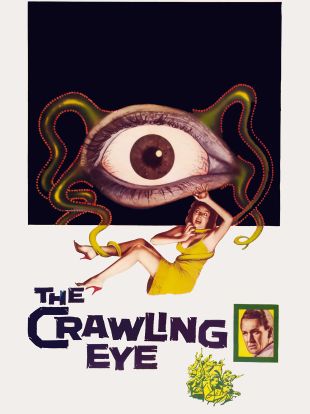
In 1953, the BBC presented a serial (what we would define as a miniseries) called The Quatermass Experiment, authored by Nigel Kneale, a science-fiction thriller with a strong horror and mystery component that took England by storm; it was transformed into a feature film called The Quatermass Xperiment (the spelling emphasizing its British X rating, indicating it was not to be seen by children), produced by Hammer FIlms and directed by Val Guest, with American Brian Donlevy playing Professor Quatermass, which was even more successful. Even more remarkably, retitled The Creeping Unknown for its U.S. release by United Artists, it became a huge hit in the United States. In 1956, the fledgling British ITV television network tried its hand at presenting something along the same lines as part of its Saturday Serials, a six-part science fiction thriller with mystery and horror elements called The Trollenberg Terror, authored by Peter Key and directed by Quentin Lawrence, with Laurence Payne as the hero, Philip Truscott. It was similarly successful for the new rival to the BBC, keeping audiences glued to their sets for six weeks across December of 1956 and January of 1957. The series' production company, Tempean, looking at what Hammer had done with Kneale's Quatermass series, saw the cinematic possibilities and prepared a feature film version, scripted by Jimmy Sangster and with American actor Forrest Tucker in the lead -- at the time, it was believed that casting a recognizable American name in a British picture would boost a movie's box-office potential at home and also help when it came to getting it distributed in America. The resulting film, also directed by Quentin Lawrence and with Laurence Payne cast in the now co-starring role of Philip Truscott, was retitled The Crawling Eye for its American release, its distributors hoping to draw the same audiences that had made The Creeping Unknown a hit in the United States. The film is still remembered, 50 years after it was released, as one of the creepier science fiction thrillers of its time, even if some of the creepiest shock moments in it are sort of illogical. Lawrence, whose approach to the six-part television story was far more deliberate, keeps the action moving here at such a good clip, however, that viewers tend to leap right over the illogical aspects (helped, of course, by the sheer creepiness of severed heads, etc.). Sangster's script balances the horrific and mysterious elements, carrying the viewer back and forth between a search across a mountain that results in three (or is it four?) horrible murders, and the wanderings of the young clairvoyant Ann Pilgrim (Janet Munro) as she is taken over for a time by the thought transmissions from the mountain. And for all of the illogically creepy moments, there are others -- such as Brett's attack on Ann -- that are so logical in their structure that they're a marvel of horror storytelling. The script and the director get a lot of help from a generally excellent cast -- Forrest Tucker makes a rugged hero while still being convincingly intellectual, and Laurence Payne, in his somewhat reduced role, adds some extra energy to the proceedings; Warren Mitchell carries a lot of the script and the storytelling as Professor Crevett; and Jennifer Jayne and Janet Munro, as the two sisters who are in jeopardy from the horror on the mountain, make a convincing pair of siblings, with Munro giving one of the best performances of her tragically short career. The production is also helped by the unusually good photography, courtesy of Monty Berman (with future director Desmond Davis operating the camera), which deliberately alternates styles -- flat and realistic in the exterior and establishing shots, as though one is watching a travelogue; and richer in contrast and detail as the dramatic scenes proceed, the one style enhancing the impact of the other. Stanley Black, best remembered as a conductor, also provides a surprisingly good score. The only moments where the movie does lapse are a couple of very bad special effects shots involving the alien invaders attacking the heroes, and one terrible use of a model plane in the climactic aerial attack on the alien invaders, which looks completely amateurish in one shot.
